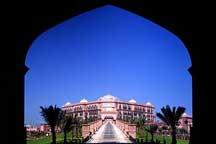Introduction of Yalu River
2009-07-20 17:34 BJT
The Yalu River (Chinese) or the Amnok River (Korean) is a river on the border between China and North Korea. The Chinese name comes from a Manchu word meaning "the boundary between two countries". The Korean name is the Korean pronunciation of the same Chinese characters.
 |
|
Map of Yalu River, Asia |
Geography
The river is 790 km (491 mi) long and receives the water from over 30,000 km² of land. The Yalu's most significant tributaries are the Changjin (장진강, 長津江), Heochun (허천강, 虛川江) and Tokro rivers. The river is not easily navigable for most of its length: although at its widest it is around 5 km, the depth is no greater than 3 m and much of the river is heavily silted.
History
The river basin is the site where the ancient kingdom of Goguryeo rose to power. Many former fortresses are located along the river and the former capital of that kingdom was situated at what is now the medium-sized city of Ji'an, China along the Yalu, a site rich in Goguryeo era relics.
The Korean side of the river was heavily industrialized during the Japanese Colonial Period (1910–1945), and by 1945 almost 20% of Japan's total industrial output originated in Korea. During the Korean War the movement of UN troops approaching the river provoked massive Chinese intervention from around Dandong. In the course of the conflict every bridge across the river except one was destroyed.
Economy
The river is important for hydroelectric power, and one of the largest hydroelectric dams in Asia is in Sup'ung Rodongjagu, 100 m high and over 850 m long, located upstream from Sinuiju, North Korea. In addition the river is used for transportation, particularly of lumber from its forested banks. The river provides fish for the local population.
Editor: Zheng Limin | Source: CCTV.com
 Mail
Mail Share
Share Print
Print


 Video
Video









 2009 China Central Television. All Rights Reserved
2009 China Central Television. All Rights Reserved